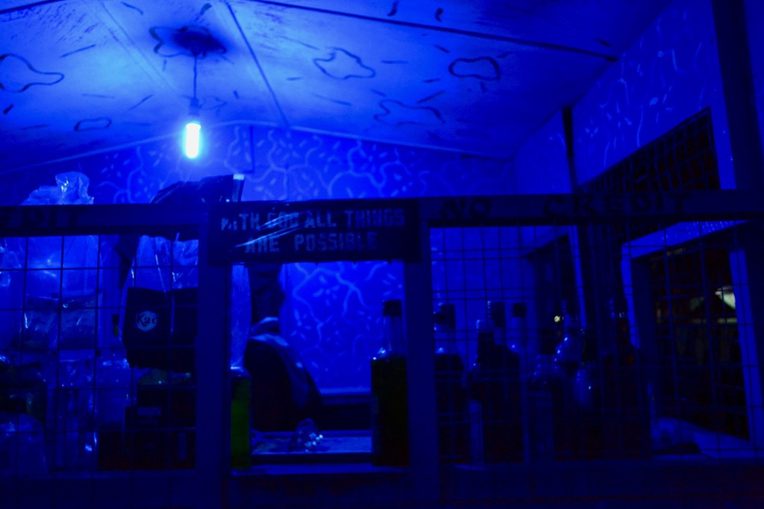Our Electric Illuminations
From the Series: Our Lives with Electric Things
From the Series: Our Lives with Electric Things


In the Eden of lights-off romance, the blue lightbulb. Iron containers, concrete rooms, and midnight trotros turned into blue capsules of dreams, space pods under the silent skies. He says: “Blue light is for the bedroom. It’s cool, you know, it’s down. When the blue light is there, it shines and it makes things look beautiful. It makes things better.”
In the crisis of darkness, the dusty sweat of the heat, electric solace: beauty blue. Love and coolness, “fresh boy fresh girl,” shimmering skins, crispy kisses on parched lips. There is beauty in the crisis, a necrotic sweetness of being, an electric cooling of the soul. She says: “Blue light gives a nice flavor”—an electric delicacy.
Accra city lights: wealth and power in the differential valuations of brightness and shades, in the nuanced appreciation of the concealing, enhancing, entrancing, transformative possibilities of light as technologies of desire. Electric summons in thermo-tonal diffusions of shine and glow, speed and depth: raw white spider lightbulbs because “brightness is happiness,” spinning pink and green flashes for Ghallywood movies, heated kerosene flames for the feast of the hungry. Above all, beauty blue: turning dirt into beauty, love into romance. Neon blood. Beauty blue: “With God all things are possible.”
Blue light: a chimeric technology of the sacred. Cash beauty: no credit.Blue light like a flicker of hope, a beacon of divine forgiveness for tormented embraces. Blue shy: modesty and the repressed extravagance of lust in the cooling of the flesh. They say: “Blue is attraction; blue is romance; blue is beauty; in Ghana, blue is the color of love.”
Beauty blue: sanity in protest. Electric catharsis.

Celebrations tend to be illuminated in one way or another—we like to see ourselves having a good time. This lamp, a baraat lalten, was one of three carried by musician-ushers recruited to guide the guests on the groom’s side through the streets of Srinagar in Uttarakhand, India. We were making our way to meet the bride’s family. The couple, Anupam and Seema, would receive their guests together amid clouds of marigolds.
Lighting our path, the baraat laltens were wired to a stack of car batteries, further arrays of high-output bulbs, and a riotous sound system all mounted on the trolley that headed the procession, helping to keep things lit. There were drums, trumpets, cheers, and an occasional pause for guests to shower the musicians with ten-rupee notes—brief gestures of exuberance caught in the light of the lamps.
These moments offered a break from necessity; a chance to dismiss the world that positions communities along an economic scale of surplus (at its poles are those awash with excessive wealth or those rendered excess to its accumulation). Such moments are not limited to any one time, place, or celebration. Instead, they emerge within diverse displays of money, joy, light, and power.
For Georges Bataille, the eternal play of sunlight engulfs all living matter with extravagance. Such abundance encourages action that stems from a general sense of energy and possibility: action that isn’t limited by a particular end. Purpose is peripheral to practice. In such a world, individuals stand at the heart of a web of resources, some actual and in hand, others distant or denied, and still others in a state of mere potential. In the right light, to celebrate one’s place in the web is to embrace the wealth it represents, no matter the circumstances.

“Communism is Soviet power plus the electrification of all the country,” proclaimed Lenin at a 1920 party conference. In the midst of civil war violence and chaos, he put forward a vision of a distant future, where political and electric power is fused—where “the Russian proletarian state holds all the strings of the large-scale industrial machine.”
Yet this technosocial imagery does not just energize, but serves to redo the Soviet concept of political power. It ceases to be just something one takes and holds (an understanding to which Michel Foucault was later to object) and becomes, like electric power, something one makes and gives. From the first stations that powered the villages of central Russia to the gigantic hydroelectric dams that came to epitomize Soviet-style development worldwide, this productive and emanating electric power had generated some of the most vivid idioms of political power that gives. It disrupts the darkness of history with a Promethean gift of light. It generates the figure of the revolutionary giver: “Lenin’s light,” a nickname for the electric lightbulb in the Russian peasant vernacular.
It multiplies this figure into a trinity of the worker, party, and leader, as in this gift from workers to the Twelfth Party Congress: “‘We are here to present our labor,’ spoke the head of the workers’ delegation, ‘that is, this lamp, so as to illuminate the Congress . . . to illuminate our dear Valdimir Illyitch [Lenin] . . . and let our lamp, made by our calloused hands, be a beacon to all. Long live the World Revolution!”